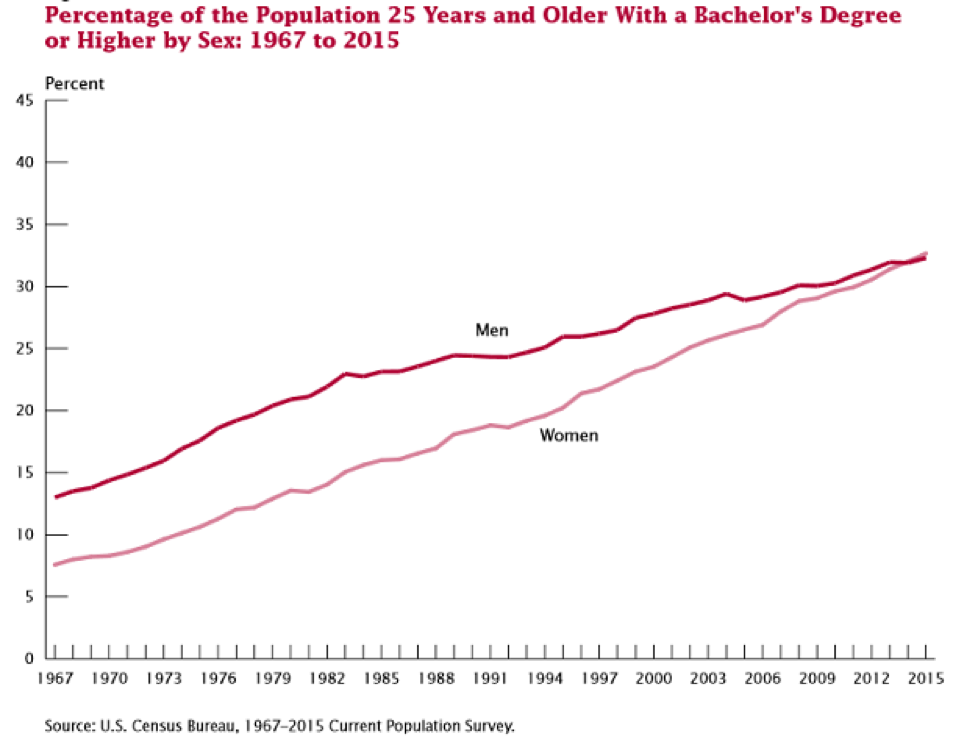More Americans are getting college degrees but recent gains haven’t been uniform across all parts of the population, according to a new Census study.
The difference between men and women has been eliminated, but there are still gaps in educational attainment between racial and ethnic groups. Certain immigrant groups are more likely to pursue advanced degrees than their U.S.-born counterparts, but immigrants’ college attainment overall falls behind native-born citizens.
One-third of Americans held a bachelor’s degree or higher in 2015, up from just under a quarter in 1995. The increase has been driven by more young people going to college. Thirty-six percent of 25 to 29-year-olds held a four-year degree or higher, versus 25 percent in 1995 and 21 percent in 1975.
Almost nine in 10 Americans had a high school diploma or equivalent in 2015.
Related: College Students Are Missing Out on Billions in Free Financial Aid
Gender gap no more
A third of men and women held a bachelor’s degree or higher in 2015 after a half-century of females trailing males in the category.
From 1970 to 1990, women lagged by six to eight percentage points. In 2000, the gap had fallen to four percentage points and by 2010 the difference was down to one point. In 2015, women had the (statistically insignificant) edge with 32.7 percent holding higher degrees versus 32.3 percent for men.

However, looking at younger women and men, differences become more apparent. Women between 25 and 29 started to have higher college attainment than men in 1996 and have continued since.
The same largely holds true when race and ethnicity are taken into account. White (non-Hispanic), Black and Hispanic women between 25 and 34 were more likely to have a four-year degree than their male counterparts since 1996. Asian women attained that distinction in 2010.
Related: As States Cut Funding, Tuition at Public Colleges Soar
Racial and ethnic lines
Asians were the most highly educated of any other group, but their growth in education attainment since 1988 has been the smallest. Fifty-four percent of Asians (both U.S.-born and immigrants) hold a bachelor’s degree or higher, up 42 percent from 1988.
The percentage of non-Hispanic whites with four-year degrees or more grew 71 percent over the same period, from 21 percent to 36 percent. The share for Blacks doubled from 11 percent in 2015 to 22 percent in 2015.
Education attainment by Hispanics only grew by half during that time, increasing from 10 percent to 15 percent. However, if foreign-born Hispanics aren’t included, then 20 percent of Hispanics had college degrees in 2015, an increase of 100 percent.
Related: Here’s Why the College Graduation Rate is So Low
Immigrants vs. U.S.-born
A much larger share of immigrants are poorly educated compared with U.S.-born citizens. More than a quarter of foreign-born residents (28 percent) have less than a high-school education, versus only 8.2 percent of natural-born citizens.
Education attainment of immigrants substantially trails U.S.-born citizens until the higher degree categories, where 18.9 percent of immigrants have bachelor’s degrees versus 20.8 percent of U.S.-born residents. At the highest end, immigrants come out on top with 12.5 percent having advanced degrees versus 11.9 percent for natives.
The disparity at the lower end is largely due to Hispanic immigrants. Only 12 percent of Hispanic immigrants have a four-year degree or higher, compared with 20 percent of native Hispanics.
A higher proportion of white and black immigrants both have bachelor's degrees or higher than their U.S.-born counterparts. The share of Asians with higher degrees — immigrants or U.S.-born — are statistically identical.





